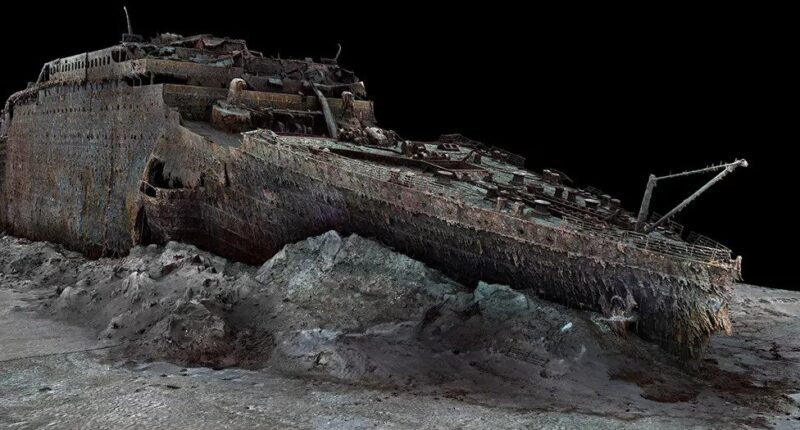THE Titanic rests on the sea bed like a toppled skyscraper, surrounded by dozens of lost shoes and unopened bottles of champagne.
Amazing new digital scans reveal the world’s most famous shipwreck in its entirety, preserved in the ice-cold Atlantic waters, for the first time in more than a century.
The extraordinarily detailed images, captured by remote- controlled submersibles, are the result of over 200 hours of surveying the wreck and digitally stitching together more than 700,000 shots to create a precise 3D reconstruction.
And the results have sparked fresh claims about how the luxury liner came to grief on its maiden voyage to New York in 1912.
The instantly recognisable bow section, complete with anchor and deckside railings, is remarkably well preserved.
The stern is a twisted mass of metal — its luxury decks pancaked down on one another — caused when the rear section of the ship corkscrewed into the sea floor as it sank.


Statues and ornaments are scattered around the vessel and one image shows a serial number on one of Titanic’s giant propellers.
Its grand staircase, which swept well-heeled diners from the deck to the first-class dining saloon, is now a gaping hole.
Behind the chasm is the area of promenade deck where the eight-piece band played on as Titanic slowly slipped below the waves.
Now it is hoped the vivid scans will finally help to pinpoint which part of the ship struck the iceberg that led to its doom.
Most read in Tech
It sank on April 15, 1912, with the loss of 1,517 lives after sailing into an ice field and was holed beneath the water line, 400 miles south of Newfoundland.
Just 706 people survived the disaster — although the ship’s 20 lifeboats were on average only 60 per cent full.
Many died within minutes of being thrown into the -2C waters.
Titanic researcher Parks Stephenson, 65, believes the 3D imaging “will open the door” to examining where the iceberg struck the liner.
He said: “I’ve got a growing amount of evidence that Titanic didn’t hit the iceberg along its side, as is shown in all the movies.
“She may actually have grounded on the submerged shelf of the ice. That was the first scenario put out by a London magazine in 1912.
“Maybe we haven’t heard the real story of Titanic yet.”
For years it was believed that Titanic had sunk in one piece, and schemes were hatched to attempt to raise it.
But when the wreck was finally discovered 3,800m (12,500ft) below the surface in 1985 it was found to have sheared in two.
Until now, images of the wreck have been frustratingly poor due to the murky water and pitch- dark conditions.
Gerhard Seiffert, of deep-sea mapping company Magellan — which produced the new images in partnership with documentary maker Atlantic Productions — said: “The depth of it, almost 4,000 metres, represents a challenge. You have currents at the site too, and we’re not allowed to touch anything so as not to damage the wreck.”
Andrew Geffen, of Atlantic Productions, said: “Great explorers have been down to the Titanic, but they went with really low-resolution cameras and they could only speculate on what happened.
“We now have every rivet of the Titanic, every detail. We can put it back together, so for the first time we can actually see what happened and use real science to find out what happened.
“It will take a long time to go through all those details but literally week by week there are new findings.”
Iron-eating microbes have colonised the ship. In 2006 it was estimated that within 50 years Titanic’s hull would collapse entirely, with only the more durable interior fittings remaining.
The sinking has proved an enduring fascination to film-makers and the public alike.


The latest images — with their otherworldly feel — will only provoke further intrigue over the doomed liner.
Parks Stephenson added: “There is still much to learn from the wreck, which is essentially the last surviving eyewitness to the disaster. She has stories to tell.”


















